Comparison of Time-of-Flight and Phase-Shift TLS Intensity Data for the Diagnostics Measurements of Buildings
Abstract
1. Introduction
2. Motivation
3. Theoretical Background of TLS
3.1. Radiometric Information of a Laser Beam
3.2. TOF and Phase-Shift Principle Distance Measurement in TLS
4. Scope and Methodology
4.1. Materials and Methods
4.2. Results of Post-Processing
4.2.1. Radiometric Analysis of the TLS Point Cloud
- ✓
- AA profile—brick wall with damaged plaster
- ✓
- BB profile—wall with a patch of falling paint
- ✓
- CC profile—brick walls from different periods of time
- Second campaign (see Figure 3)
- ✓
- DD profile—crack in the wall
- ✓
- EE profile—brick wall with damaged plaster
- ✓
- FF profile—weathered part of the wall
4.2.2. Geometric Analysis of the TLS Point Cloud
5. Discussion
6. Conclusions
Funding
Conflicts of Interest
References
- Katzer, J.; Kobaka, J. Combined non-destructive testing approach to waste fine aggregate cement composites. Sci. Eng. Compos. Mater. 2009, 16, 277–284. [Google Scholar] [CrossRef]
- Saint-Pierre, F.; Philibert, A.; Giroux, B.; Rivard, P. Concrete Quality Designation based on Ultrasonic Pulse Velocity. Constr. Build. Mater. 2016, 125, 1022–1027. [Google Scholar] [CrossRef]
- Martínez-Carricondo, P.; Carvajal-Ramírez, F.; Yero-Paneque, L.; Agüera-Vega, F. Combination of nadiral and oblique UAV photogrammetry and HBIM for the virtual reconstruction of cultural heritage. Case study of Cortijo del Fraile in Níjar, Almería (Spain). Build. Res. Inf. 2019, 48, 140–159. [Google Scholar] [CrossRef]
- Remondino, F. Heritage recording and 3D modeling with photogrammetry and 3D scanning. Remote Sens. 2011, 3, 1104–1138. [Google Scholar] [CrossRef]
- Alba, M.; Fregonese, L.; Prandi, F.; Scaioni, M.; Valgoi, P. Structural monitoring of a large dam by terrestrial laser scanning. Int. Arch. Photogramm. Remote Sens. Spat. Inf. Sci. 2006, 36, 1–6. [Google Scholar]
- Scaioni, M.; Marsella, M.; Crosetto, M.; Tornatore, V.; Wang, J. Geodetic and remote-sensing sensors for dam deformation monitoring. Sensors 2018, 18, 3682. [Google Scholar] [CrossRef] [PubMed]
- Suchocki, C. Application of terrestrial laser scanner in cliff shores monitoring. Rocz. Ochr. Sr. 2009, 11, 715–725. [Google Scholar]
- Shen, Y.; Wang, J.; Lindenbergh, R.; Hofland, B.; Ferreira, V.G. Range image technique for change analysis of rock slopes using dense point cloud data. Remote Sens. 2018, 10, 1792. [Google Scholar] [CrossRef]
- Lõhmus, H.; Ellmann, A.; Märdla, S.; Idnurm, S. Terrestrial laser scanning for the monitoring of bridge load tests–two case studies. Surv. Rev. 2018, 50, 270–284. [Google Scholar] [CrossRef]
- Riveiro, B.; DeJong, M.J.; Conde, B. Automated processing of large point clouds for structural health monitoring of masonry arch bridges. Autom. Constr. 2016, 72, 258–268. [Google Scholar] [CrossRef]
- Sánchez-Rodríguez, A.; Riveiro, B.; Soilán, M.; González-deSantos, L.M. Automated detection and decomposition of railway tunnels from Mobile Laser Scanning Datasets. Autom. Constr. 2018, 96, 171–179. [Google Scholar] [CrossRef]
- Cabo, C.; Ordóñez, C.; Argüelles-Fraga, R. An algorithm for optimizing terrestrial laser scanning in tunnels. Autom. Constr. 2017, 83, 163–168. [Google Scholar] [CrossRef]
- Erdélyi, J.; Kopacik, A.; Kyrinovič, P. Construction control and documentation of facade elements using terrestrial laser scanning. Appl. Geomat. 2018, 10, 113–121. [Google Scholar] [CrossRef]
- Suchocki, C.; Damięcka, M.; Jagoda, M. Determination of the building wall deviations from the vertical plane. In Proceedings of the 7th International Conference on Environmental Engineering, ICEE 2008-Conference Proceedings, Vilnius, Lithuania, 22–23 May 2008; pp. 1488–1492. [Google Scholar]
- Costa-Jover, A.; Lluis i Ginovart, J.; Coll-Pla, S.; López Piquer, M. Using the terrestrial laser scanner and simple methodologies for geometrically assessing complex masonry vaults. J. Cult. Herit. 2019, 36, 247–254. [Google Scholar] [CrossRef]
- Di Filippo, A.; Sánchez-Aparicio, L.J.; Barba, S.; Martín-Jiménez, J.A.; Mora, R.; Aguilera, D.G. Use of a wearable mobile laser system in seamless indoor 3D mapping of a complex historical site. Remote Sens. 2018, 10, 1897. [Google Scholar] [CrossRef]
- Newnham, G.J.; Armston, J.D.; Calders, K.; Disney, M.I.; Lovell, J.L.; Schaaf, C.B.; Strahler, A.H.; Mark Danson, F. Terrestrial laser scanning for plot-scale forest measurement. Curr. For. Rep. 2015, 1, 239–251. [Google Scholar] [CrossRef]
- Watt, P.J.; Donoghue, D.N.M. Measuring forest structure with terrestrial laser scanning. Int. J. Remote Sens. 2005, 1437–1446. [Google Scholar] [CrossRef]
- Nield, J.M.; Wiggs, G.F.S.; Squirrell, R.S. Aeolian sand strip mobility and protodune development on a drying beach: Examining surface moisture and surface roughness patterns measured by terrestrial laser scanning. Earth Surf. Process. Landf. 2011, 36, 513–522. [Google Scholar] [CrossRef]
- Barazzetti, L.; Sala, R.; Scaioni, M.; Cattaneo, C.; Gibelli, D.; Giussani, A.; Poppa, P.; Roncoroni, F.; Vandone, A. 3D scanning and imaging for quick documentation of crime and accident scenes. In Sensors, and Command, Control, Communications, and Intelligence (C3I) Technologies for Homeland Security and Homeland Defense XI; SPIE: Baltimore, MD, USA, 2012; pp. 1–14. [Google Scholar]
- Laefer, D.F.; Truong-Hong, L.; Carr, H.; Singh, M. Crack detection limits in unit based masonry with terrestrial laser scanning. NDT E Int. 2014. [Google Scholar] [CrossRef]
- Teza, G.; Galgaro, A.; Moro, F. Contactless recognition of concrete surface damage from laser scanning and curvature computation. NDT E Int. 2009, 42, 240–249. [Google Scholar] [CrossRef]
- Bucksch, A.; Lindenbergh, R.C.; Van Ree, J. Error budget of Terrestrial Laserscanning: Influence of the intensity remission on the scan quality. In Proceedings of the III International Scientific Congress Geo-Siberia, Novosibirsk, Russia, 23–27 April 2007; pp. 113–122. [Google Scholar] [CrossRef]
- Xu, T.; Xu, L.; Yang, B.; Li, X.; Yao, J. Terrestrial laser scanning intensity correction by piecewise fitting and overlap-driven adjustment. Remote Sens. 2017, 9, 1090. [Google Scholar] [CrossRef]
- Voegtle, T.; Schwab, I.; Landes, T. Influences of different materials on the measurements of a terrestrial laser scanner (TLS). In Proceedings of the International Archives of the Photogrammetry, Remote Sensing and Spatial Information Sciences, Beijing, China, 3–11 July 2008; Volume XXXVII, pp. 1061–1066. [Google Scholar]
- Pfeifer, N.; Höfle, B.; Briese, C.; Rutzinger, M.; Haring, A. Analysis Of The Backscattered Energy In Terrestrial Laser Scanning Data. In Proceedings of the International Archives of the Photogrammetry, Remote Sensing and Spatial Information Science, Beijing, China, 3–11 July 2008; Volume XXXVII. B5, pp. 1045–1052. [Google Scholar]
- Suchocki, C.; Jagoda, M.; Obuchovski, R.; Šlikas, D.; Sužiedelytė-Visockienė, J. The properties of terrestrial laser system intensity in measurements of technical conditions of architectural structures. Metrol. Meas. Syst. 2018, 25, 779–792. [Google Scholar] [CrossRef]
- Rabah, M.; Elhattab, A.; Fayad, A. Automatic concrete cracks detection and mapping of terrestrial laser scan data. NRIAG J. Astron. Geophys. 2013, 2, 250–255. [Google Scholar] [CrossRef]
- Suchocki, C.; Katzer, J. Terrestrial laser scanning harnessed for moisture detection in building materials – Problems and limitations. Autom. Constr. 2018, 94, 127–134. [Google Scholar] [CrossRef]
- Tan, K.; Cheng, X.; Ju, Q.; Wu, S. Correction of Mobile TLS Intensity Data for Water Leakage Spots Detection in Metro Tunnels. IEEE Geosci. Remote Sens. Lett. 2016, 13, 1711–1715. [Google Scholar] [CrossRef]
- Armesto-González, J.; Riveiro-Rodríguez, B.; González-Aguilera, D.; Rivas-Brea, M.T. Terrestrial laser scanning intensity data applied to damage detection for historical buildings. J. Archaeol. Sci. 2010, 37, 3037–3047. [Google Scholar] [CrossRef]
- Herrera, L.K.; Le Borgne, S.; Videla, H.A. Modern Methods for Materials Characterization and Surface Analysis to Study the Effects of Biodeterioration and Weathering on Buildings of Cultural Heritage. Int. J. Archit. Herit. 2009, 3, 74–91. [Google Scholar] [CrossRef]
- Faltýnová, M.; Matoušková, E.; Šedina, J.; Pavelka, K. Building facade documentation using laser scanning and photogrammetry and data implementation into BIM. In Proceedings of the International Archives of the Photogrammetry, Remote Sensing and Spatial Information Sciences-ISPRS Archives, Prague, Czech Republic, 12–19 July, 2016; pp. 215–220. [Google Scholar]
- Yastikli, N. Documentation of cultural heritage using digital photogrammetry and laser scanning. J. Cult. Herit. 2007, 8, 423–427. [Google Scholar] [CrossRef]
- Pavlidis, G.; Koutsoudis, A.; Arnaoutoglou, F.; Tsioukas, V.; Chamzas, C. Methods for 3D digitization of Cultural Heritage. J. Cult. Herit. 2007, 8, 93–98. [Google Scholar] [CrossRef]
- Määttä, K.; Kostamovaara, J.; Myllylä, R. Profiling of hot surfaces by pulsed time-of-flight laser range finder techniques. Appl. Opt. 2009. [Google Scholar] [CrossRef] [PubMed]
- De Asís López, F.; Ordóñez, C.; Roca-Pardiñas, J.; García-Cortés, S. Point cloud comparison under uncertainty. Application to beam bridge measurement with terrestrial laser scanning. Meas. J. Int. Meas. Confed. 2014. [Google Scholar] [CrossRef]
- San José Alonso, J.I.; Martínez Rubio, J.; Fernández Martín, J.J.; García Fernández, J. Comparing Time-of-Flight and Phase-Shift. The Survey of the Royal Pantheon in the Basilica of San Isidoro (León). ISPRS−Int. Arch. Photogramm. Remote Sens. Spat. Inf. Sci. 2012, XXXVIII-5/. [Google Scholar] [CrossRef]
- Heesun, Y.; Hajun, S.; Kyihwan, P. A phase-shift laser scanner based on a time-counting method for high linearity performance. Rev. Sci. Instrum. 2011, 8, 1–4. [Google Scholar] [CrossRef]
- Jang, J.; Hwang, S.; Park, K. Intensity control of a phase-shift based laser scanner for reducing distance errors caused by different surface reflectivity. In Proceedings of the International Conference on Sensing Technology, ICST, Palmerston North, New Zealand, 28 November–1 December 2011; ICST: Palmerston North, New Zealand, 2011. [Google Scholar]
- Suchocki, C.; Katzer, J.; Rapiński, J. Terrestrial Laser Scanner as a Tool for Assessment of Saturation and Moisture Movement in Building Materials. Period. Polytech. Civ. Eng. 2018, 62, 1–6. [Google Scholar] [CrossRef]
- Suchocki, C.; Błaszczak-Bąk, W. Down-Sampling of Point Clouds for the Technical Diagnostics of Buildings and Structures. Geosciences 2019, 9, 70. [Google Scholar] [CrossRef]
- Mechelke, K.; Kersten, T.P.; Lindstaedt, M. Comparative Investigation into the Accuarcy Behaviour of the New Generation of Terrestrial Laser Scanning Systems. Opt. 3-D Meas. Tech. VIII 2007, I, 319–327. [Google Scholar]
- Truong-Hong, L. Equipment Considerations for Terrestrial Laser Scanning for Civil Engineering in Urban Areas. J. Sci. Res. Rep. 2014, 3, 2002–2014. [Google Scholar] [CrossRef]
- Van Balen, K.; Verstrynge, E. Structural Analysis of Historical Constructions: Anamnesis, Diagnosis; Taylor & Francis: Leuven, Belgium, 2017. [Google Scholar]
- RIEGL Laser Measurement Systems GmbH. LAS Extrabytes Implementation in RIEGL Software. 2017. Available online: http://www.riegl.com/uploads/tx_pxpriegldownloads/Whitepaper_LASextrabytes_implementation_in-RIEGLSoftware_2017-12-04.pdf (accessed on 12 January 2020).
- Blaskow, R.; Schneider, D. Analysis and correction of the dependency between laser scanner intensity values and range. In International Archives of the Photogrammetry, Remote Sensing and Spatial Information Sciences-ISPRS Archives; ISPRS Archives: Riva del Garda, Italy, 2014; Volume 40, pp. 107–112. [Google Scholar]
- Xu, T.; Xu, L.; Li, X.; Yao, J. Detection of Water Leakage in Underground Tunnels Using Corrected Intensity Data and 3D Point Cloud of Terrestrial Laser Scanning. IEEE Access 2018, XX, 1–9. [Google Scholar] [CrossRef]
- Höfle, B.; Pfeifer, N. Correction of laser scanning intensity data: Data and model-driven approaches. ISPRS J. Photogramm. Remote Sens. 2007, 62, 415–433. [Google Scholar] [CrossRef]
- Kaasalainen, S.; Jaakkola, A.; Kaasalainen, M.; Krooks, A.; Kukko, A. Analysis of incidence angle and distance effects on terrestrial laser scanner intensity: Search for correction methods. Remote Sens. 2011, 3, 2207–2221. [Google Scholar] [CrossRef]
- Suchocki, C.; Katzer, J.; Panuś, A. Remote Sensing to Estimate Saturation Differences of Chosen Building Materials Using Terrestrial Laser Scanner. Rep. Geod. Geoinform. 2017, 103, 94–105. [Google Scholar] [CrossRef]
- Oren, M.; Nayar, S.K. Generalization of Lambert’s reflectance model. In Proceedings of the 21st Annual Conference on Computer Graphics and Interactive Techniques-SIGGRAPH ’94, Orlando, FL, USA, 24–29 July 1994; pp. 239–246. [Google Scholar]
- Sánchez-Aparicio, L.J.; Del Pozo, S.; Ramos, L.F.; Arce, A.; Fernandes, F.M. Heritage site preservation with combined radiometric and geometric analysis of TLS data. Autom. Constr. 2018, 85, 24–39. [Google Scholar] [CrossRef]
- Kamh, G.M.E. Salt weathering, bio-deterioration and rate of weathering of dimensional sandstone in ancient buildings of Aachen City, Germany. Int. Jourmal Water Resour. Environ. Eng. 2011, 3, 87–101. [Google Scholar]
- Ahamad, N.; Ojha, S.K. The Practical Application Of Laser Scanning in A Mining Environment. In Proceedings of the 2nd National Conference on Mining Equipment: New Technologies, Challenges and Applications (MENTCA 2015)At: Indian School of Mines Dhanbad, Dhanbad, India, 9–10 October 2015; pp. 1–9. [Google Scholar]
- Bauer, A.; Paar, G.; Kaufmann, V. Terrestrial laser scanning for rock glacier monitoring. In Proceedings of the 8th International Conference on Permafrost, Zurich, Zurich, Switzerland, 20–25 July 2003; pp. 55–60. [Google Scholar]
- Przyborski, M.; Tysiąc, P. As-built inventory of the office building with the use of terrestrial laser scanning. E3S Web Conf. 2018, 26, 3–7. [Google Scholar] [CrossRef]
- Previtali, M.; Barazzetti, L.; Brumana, R.; Cuca, B.; Oreni, D.; Roncoroni, F.; Scaioni, M. Automatic façade modelling using point cloud data for energy-efficient retrofitting. Appl. Geomat. 2014, 6, 95–113. [Google Scholar] [CrossRef]
- Rüther, H.; Chazan, M.; Schroeder, R.; Neeser, R.; Held, C.; Walker, S.J.; Matmon, A.; Horwitz, L.K. Laser scanning for conservation and research of African cultural heritage sites: The case study of Wonderwerk Cave, South Africa. J. Archaeol. Sci. 2009, 36, 1847–1856. [Google Scholar] [CrossRef]
- Tan, K.; Zhang, W.; Shen, F.; Cheng, X. Investigation of TLS intensity data and distance measurement errors from target specular reflections. Remote Sens. 2018, 10, 1077. [Google Scholar] [CrossRef]
- Nejad, S.M. Comparison of TOF, FMCW and Finding Methods by Simulation. Quartarly J. Technol. Educ. 2006, 1, 11–18. [Google Scholar]
- Bechadergue, B.; Chassagne, L.; Guan, H. Visible light phase-shift rangefinder for platooning applications. 2016 IEEE 19th International Conference on Intelligent Transportation Systems (ITSC), Rio de Janeiro, Brazil , 1–4 November 2016 ; IEEE: Rio de Janeiro, Brazil, 2016; pp. 1–7. [Google Scholar]
- Chen, S.-E. Laser Scanning Technology for Bridge Monitoring. Intech 2012, 71–93. [Google Scholar] [CrossRef]
- Chen, S.; Laefer, D.F.; Byrne, J.; Natanzi, A.S. The effect of angles and distance on image-based, three-dimensional reconstructions. In Proceedings of the Safety and Reliability-Theory and Applications-Proceedings of the 27th European Safety and Reliability Conference, Portoroz, Slovenia, 18–22 June 2017; pp. 2757–2762. [Google Scholar]
- Valença, J.; Puente, I.; Júlio, E.; González-Jorge, H.; Arias-Sánchez, P. Assessment of cracks on concrete bridges using image processing supported by laser scanning survey. Constr. Build. Mater. 2017, 146, 668–678. [Google Scholar] [CrossRef]
- Hadavandsiri, Z.; Lichti, D.D.; Jahraus, A.; Jarron, D. Concrete preliminary damage inspection by classification of terrestrial laser scanner point clouds through systematic threshold definition. ISPRS Int. J. Geo-Inf. 2019, 8, 585. [Google Scholar] [CrossRef]
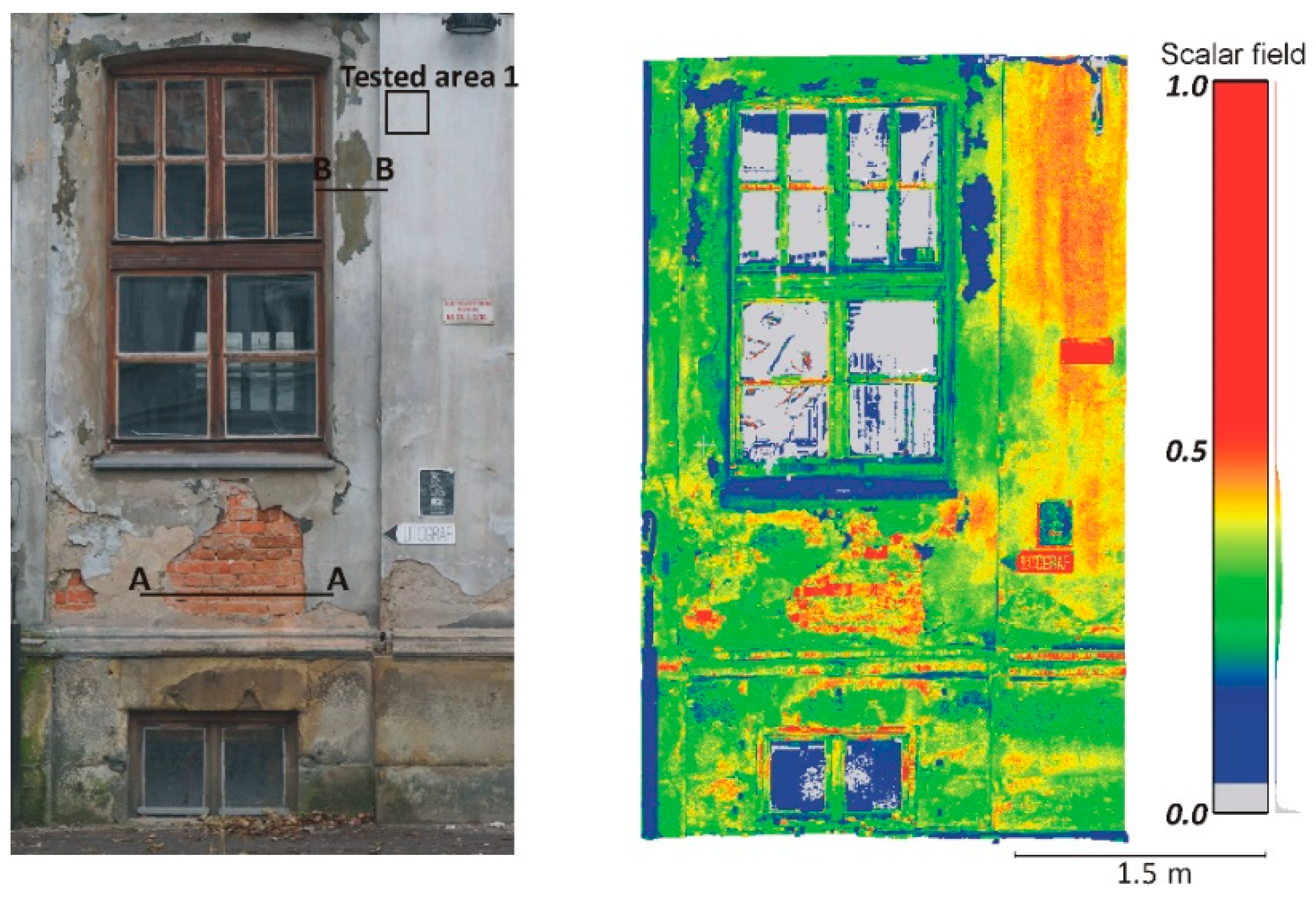

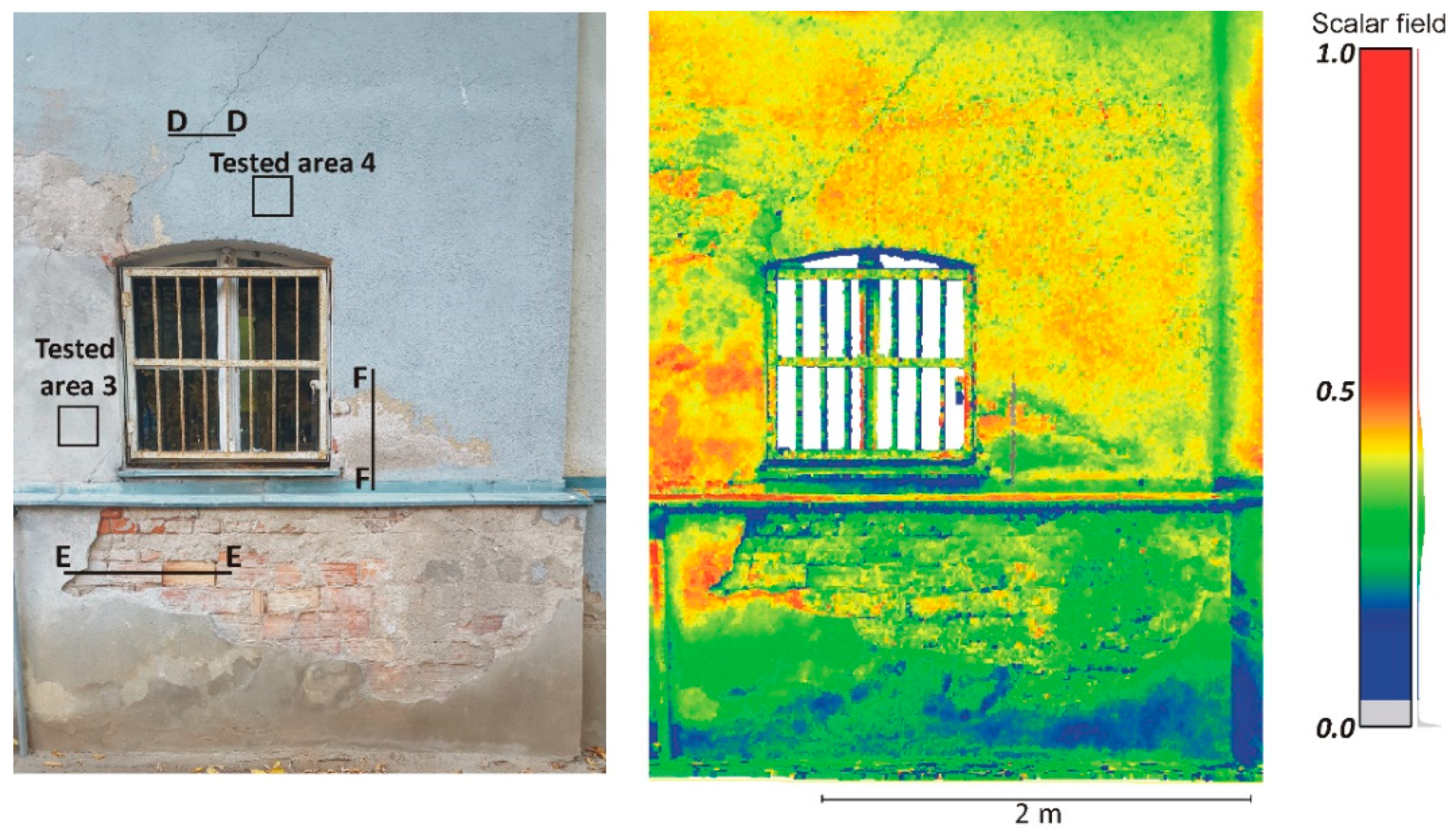

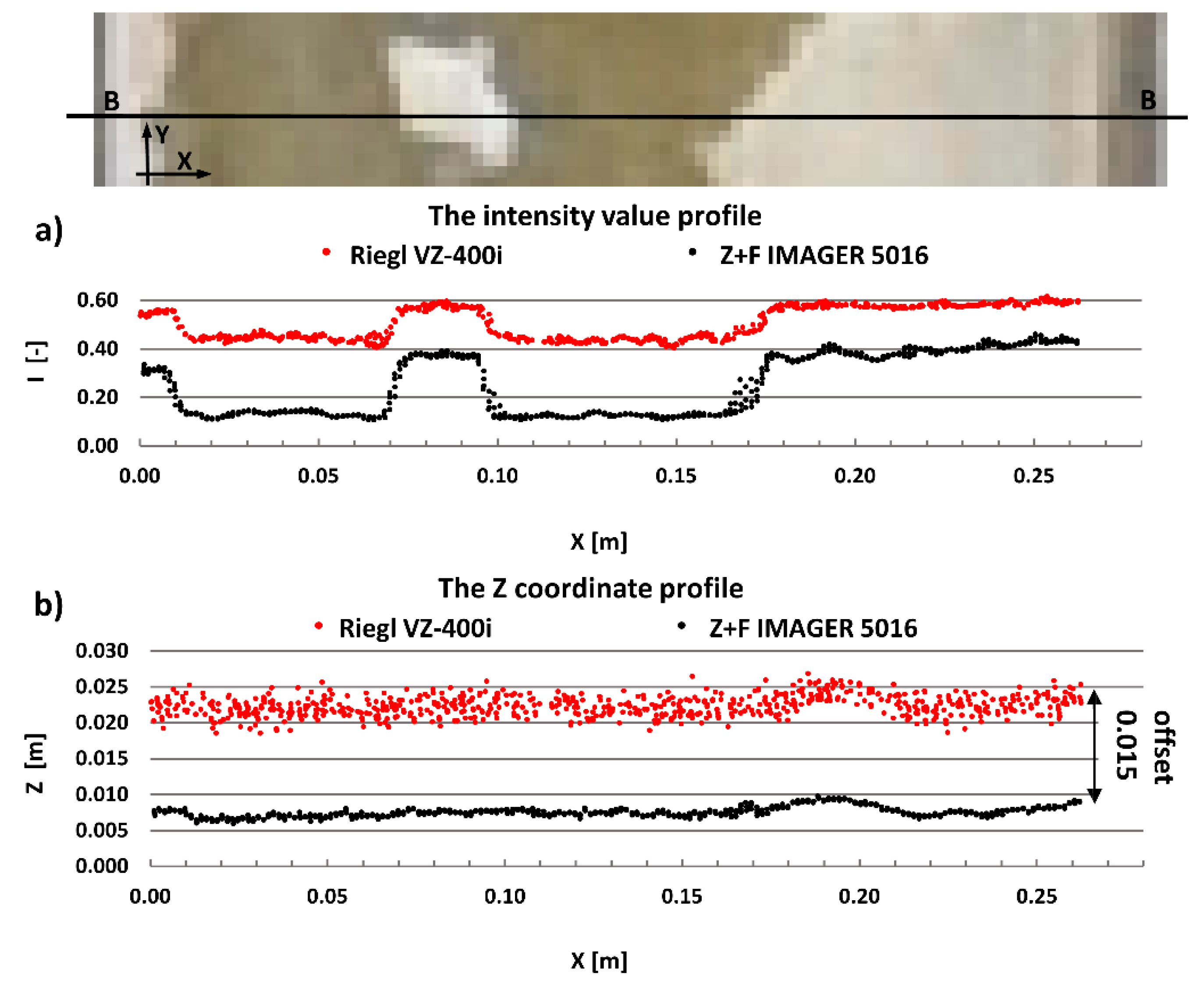

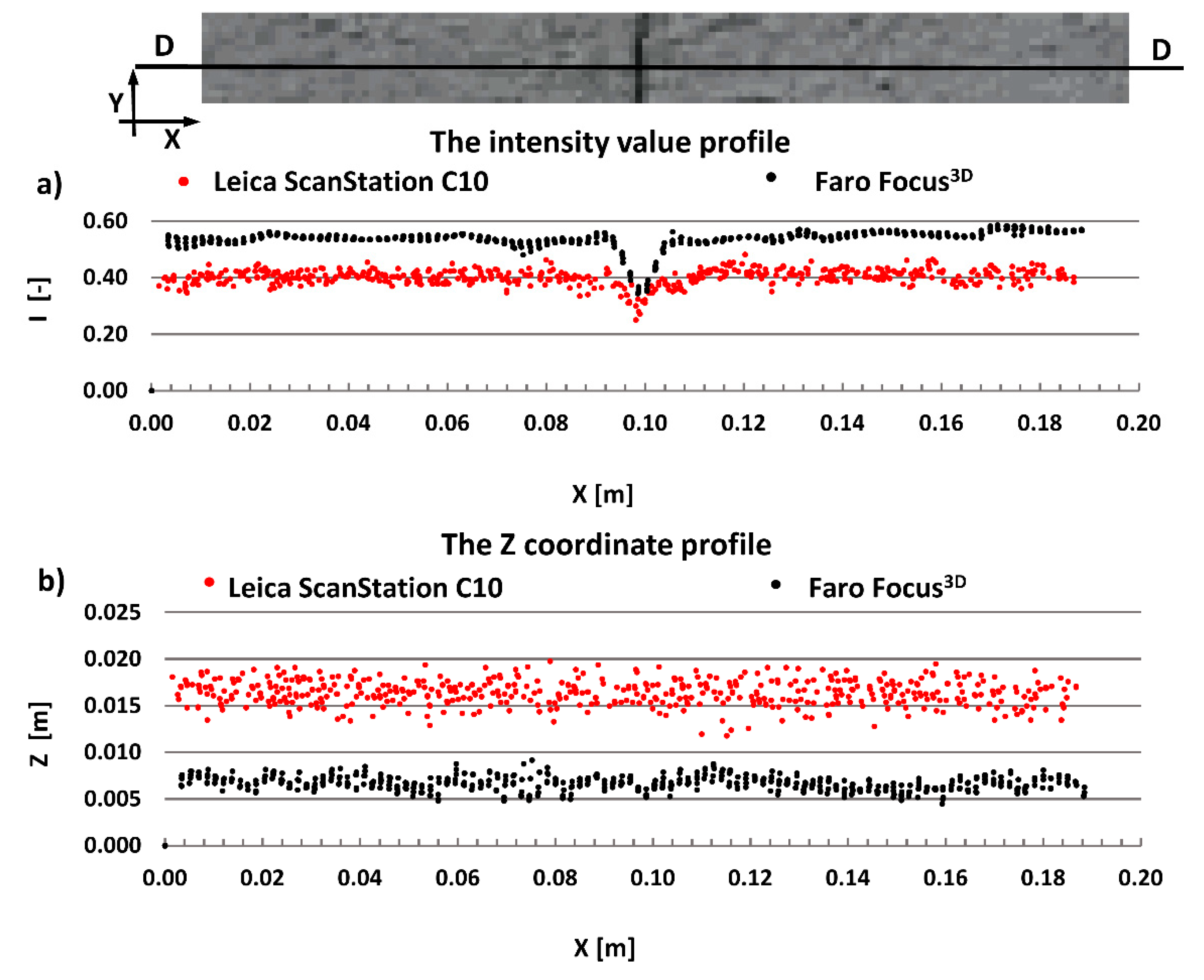
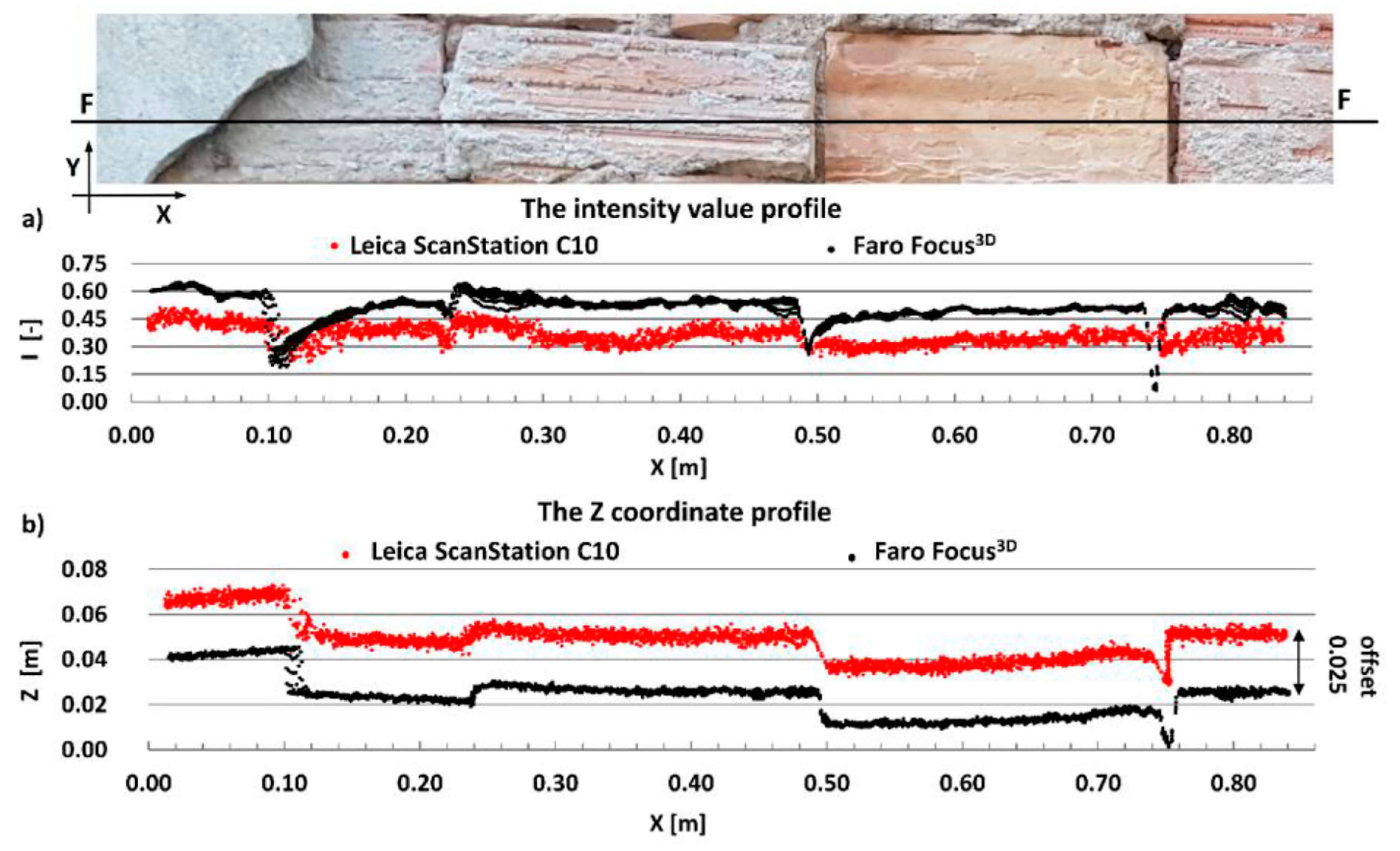
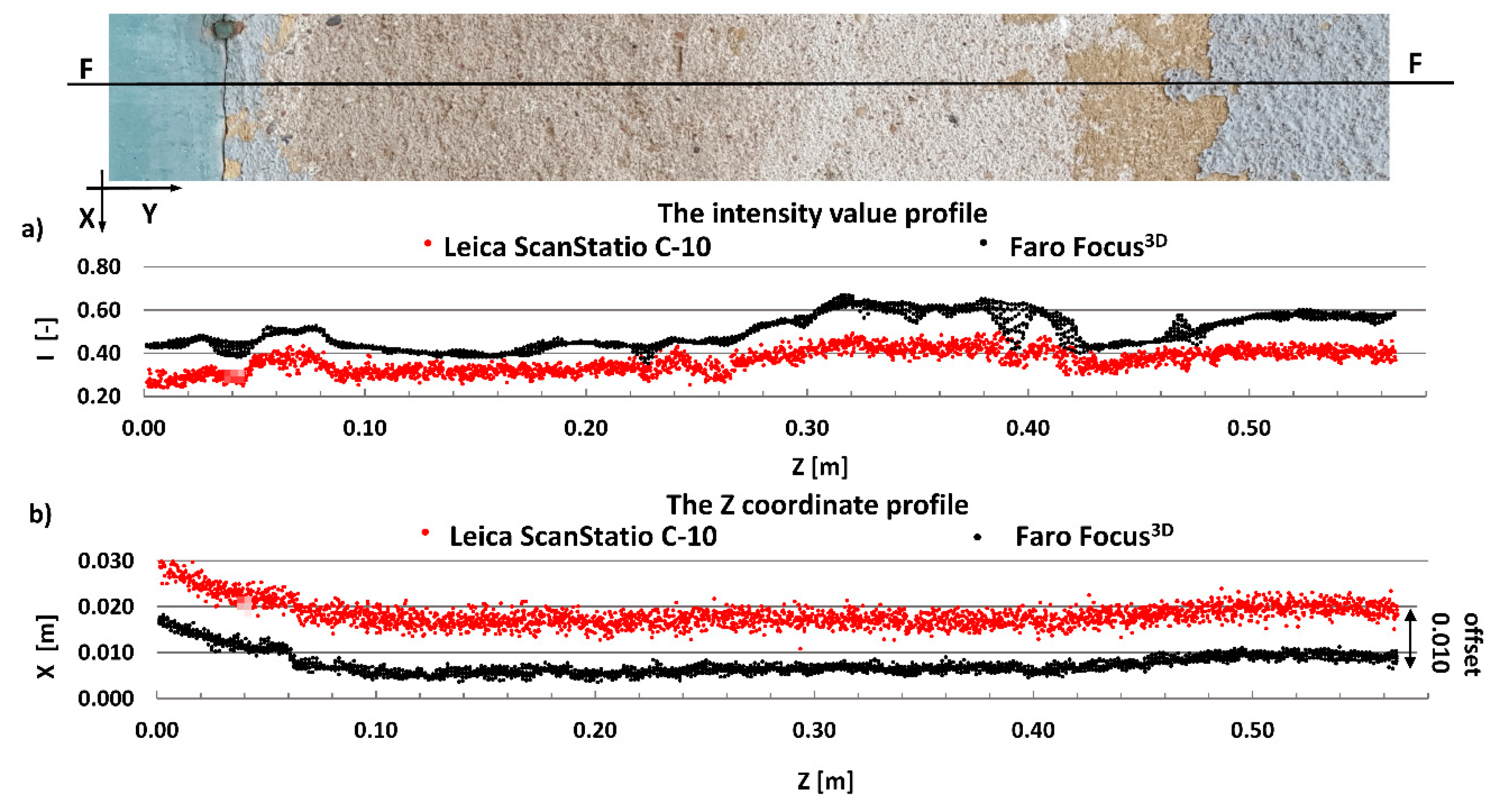
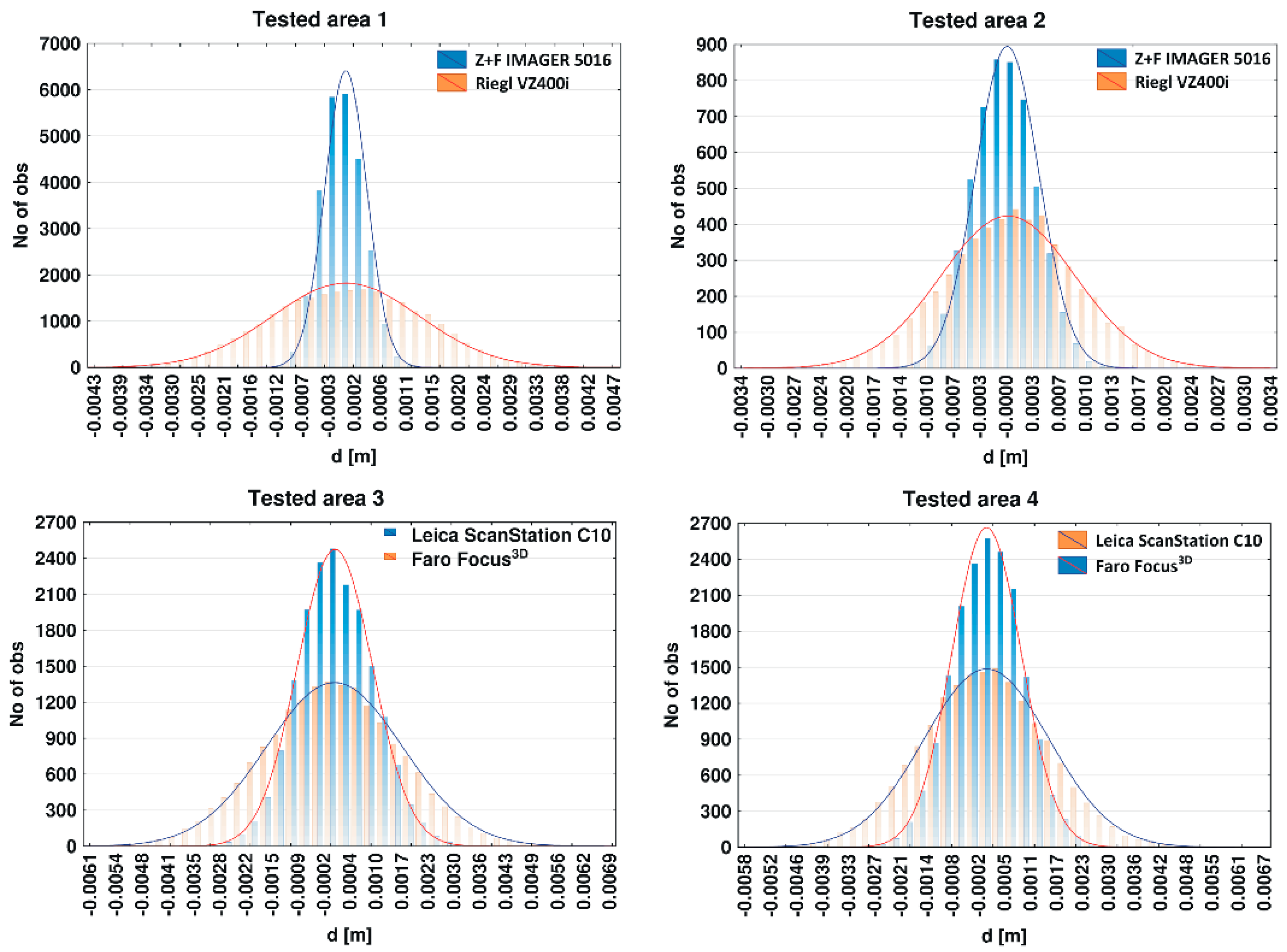
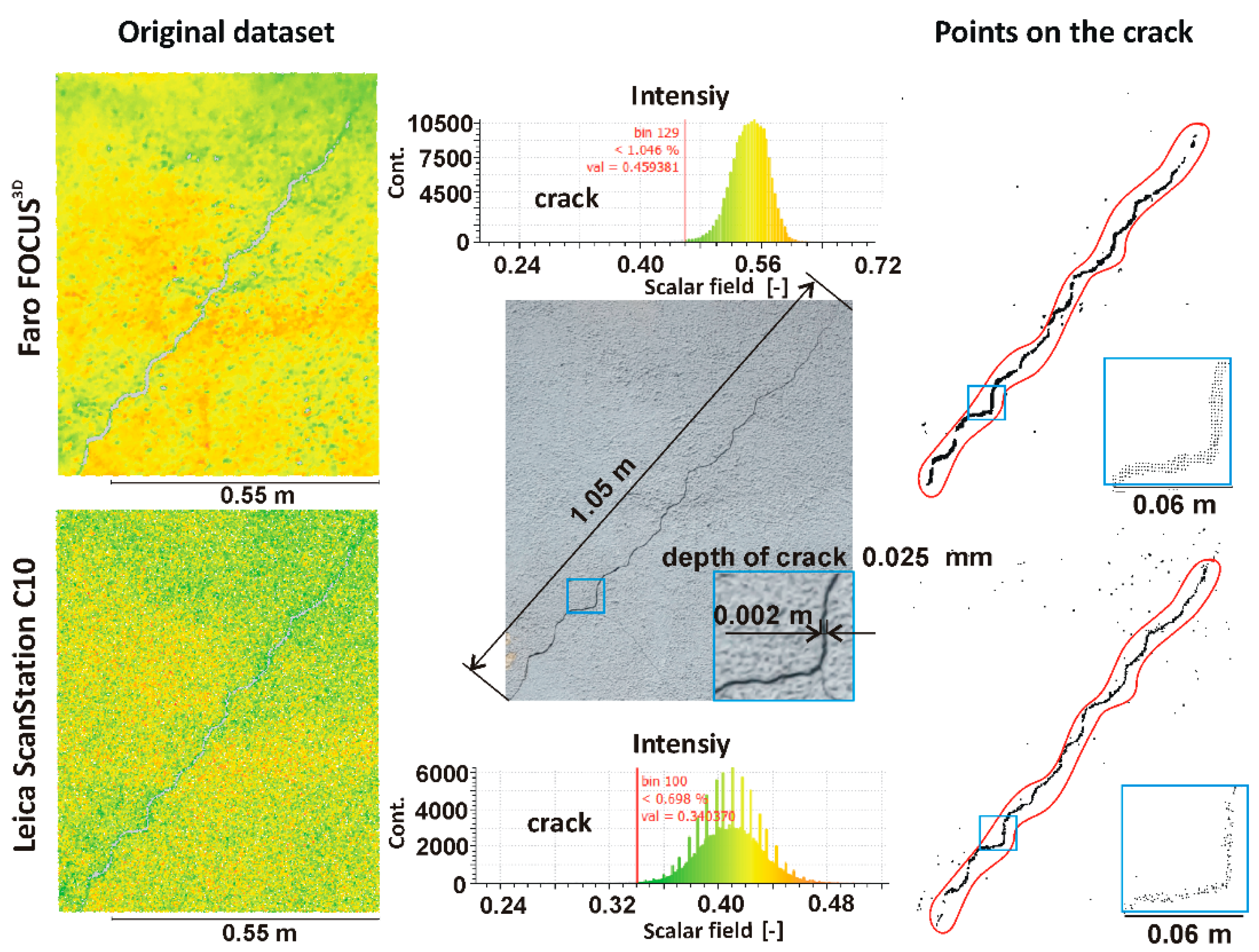
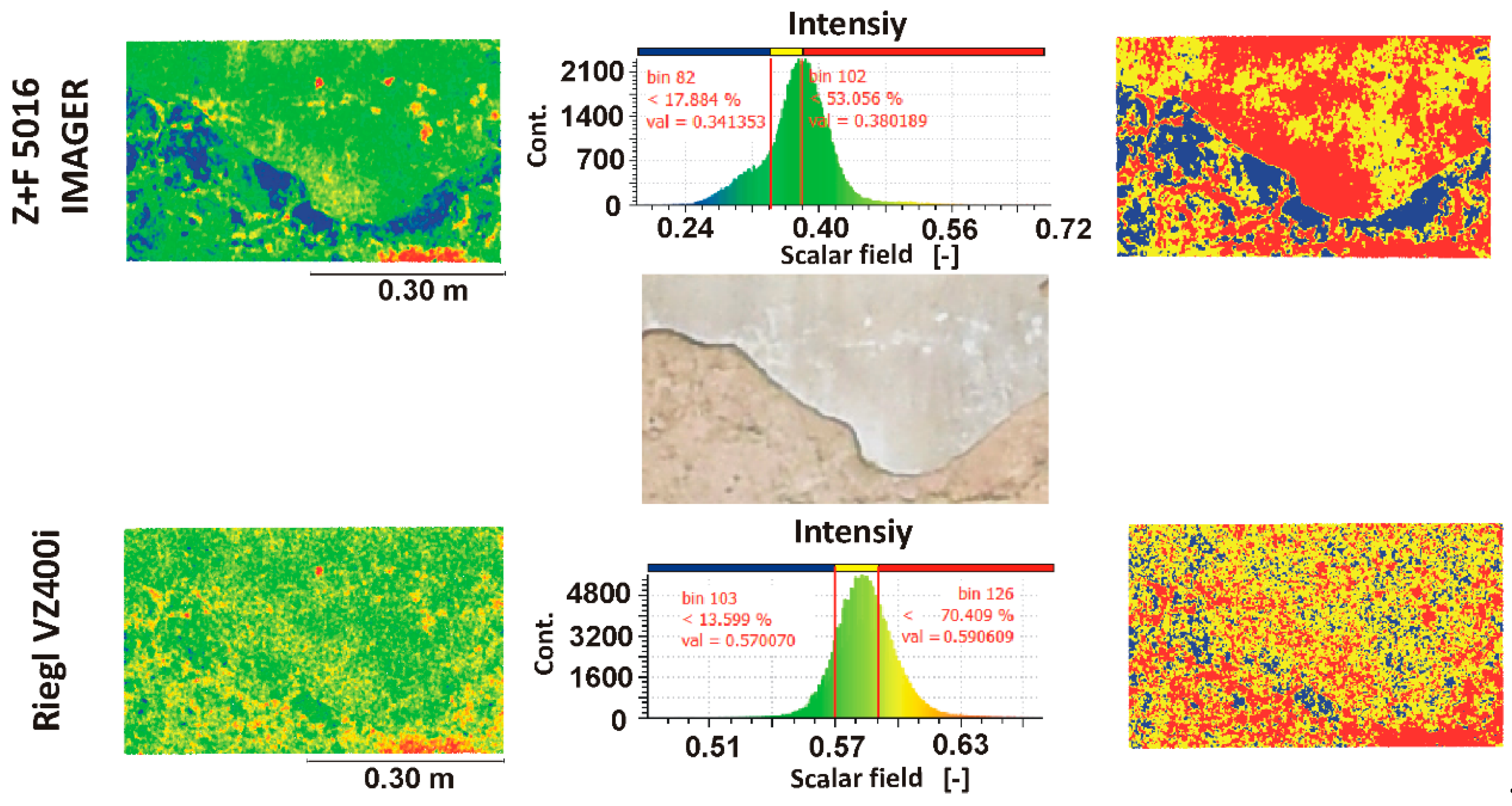
| The First Measurement Campaign | The Second Measurement Campaign | |||
| Riegl VZ-400i  | Z + F IMAGER 5016  | Leica ScanStation C-10  | Faro Focus3D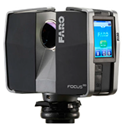 | |
| Year of Production | 2018 | 2018 | 2010 | 2010 |
| Type of Rangefinder | time-of-flight | phase-shift | time-of-flight | phase-shift |
| Wavelength | near infrared | - | 532 nm | 905 nm |
| Scan Rate Points/sec | 500,000 (1200 kHz) | 1,100,000 | Up to 50,000 | 1,000,000 |
| Range | 800 m @ 90% | 365 m | 300 m @ 90% | 120 |
| Beam Diameter | - | 3.5 mm at exit | From 0 to 50 m: 4.5 mm (FWHH-based), 7 mm (Gaussian-based) | 3 mm at exit |
| Ranging Error | 5 mm | ±1 mm + 10 ppm/m | ±4 mm within a 1–50 m range | ± 2 mm |
| Beam Divergence | 0.35 mrad | 0.3 mrad | – | 0.19mrad |
| Intensity | Firs Campaign | Second Campaign | ||||
|---|---|---|---|---|---|---|
| Riegl VZ 400i [1] | Z+F Imager 5016 [2] | [2]/[1] [3] | Leica ScanStation C10 [1] | Faro Focus3D [2] | [2]/[1] [3] | |
| AA Profile | DD Profile | |||||
| Minimum | 0.42800 | 0.11960 | 0.21948 | 0.06274 | ||
| Maximum | 0.66571 | 0.59395 | 0.51001 | 0.64868 | ||
| Range | 0.23771 | 0.47436 | 2.00 | 0.29053 | 0.58594 | 2.02 |
| BB Profile | EE Profile | |||||
| Minimum | 0.40514 | 0.10644 | 0.25000 | 0.25399 | ||
| Maximum | 0.61600 | 0.46113 | 0.48242 | 0.58618 | ||
| Range | 0.21086 | 0.35469 | 1.68 | 0.23242 | 0.33219 | 1.43 |
| CC Profile | FF Profile | |||||
| Minimum | 0.44457 | 0.09145 | 0.24048 | 0.35039 | ||
| Maximum | 0.61486 | 0.60849 | 0.49536 | 0.66914 | ||
| Range | 0.17029 | 0.51704 | 3.04 | 0.25488 | 0.31875 | 1.25 |
| No of obs. [1] | Minimum [2] | Maximum [3] | Range [4] | Std.Dev. [5] | |
|---|---|---|---|---|---|
| Tested Area 1 | |||||
| Z+F IMAGER 5016-PS | 25787 | −0.0013 | 0.0014 | 0.0027 | 0.0004 |
| Riegl VZ400i-TOF | 25787 | −0.0044 | 0.0047 | 0.0090 | 0.0013 |
| Tested Area 2 | |||||
| Z+F IMAGER 5016-PS | 5350 | −0.0013 | 0.0015 | 0.0028 | 0.0004 |
| Riegl VZ400i-TOF | 5350 | −0.0032 | 0.0033 | 0.0064 | 0.0008 |
| Tested Area 3 | |||||
| Faro Focus3D-PS | 17857 | −0.0036 | 0.0038 | 0.0074 | 0.0008 |
| Leica ScanStation C10-TOF | 17857 | −0.0058 | 0.0067 | 0.0126 | 0.0015 |
| Tested Area 4 | |||||
| Faro Focus3D-PS | 17857 | −0.0030 | 0.0031 | 0.0061 | 0.0008 |
| Leica ScanStation C10-TOF | 17857 | −0.0058 | 0.0067 | 0.0125 | 0.0015 |
| Original Dataset | Points on the Crack | |||||||
|---|---|---|---|---|---|---|---|---|
| No of points | Intensity min. | Intensity max. | Range | No of points | Intensity min. | Intensity max. | Range | |
| Faro Focus3D | 172917 | 0.18774 | 0.72681 | 0.53906 | 1655 | 0.18774 | 0.46000 | 0.27226 |
| Leica ScanStation C10 | 172917 | 0.22192 | 0.52515 | 0.30322 | 1025 | 0.22192 | 0.34000 | 0.11808 |
© 2020 by the author. Licensee MDPI, Basel, Switzerland. This article is an open access article distributed under the terms and conditions of the Creative Commons Attribution (CC BY) license (http://creativecommons.org/licenses/by/4.0/).
Share and Cite
Suchocki, C. Comparison of Time-of-Flight and Phase-Shift TLS Intensity Data for the Diagnostics Measurements of Buildings. Materials 2020, 13, 353. https://doi.org/10.3390/ma13020353
Suchocki C. Comparison of Time-of-Flight and Phase-Shift TLS Intensity Data for the Diagnostics Measurements of Buildings. Materials. 2020; 13(2):353. https://doi.org/10.3390/ma13020353
Chicago/Turabian StyleSuchocki, Czesław. 2020. "Comparison of Time-of-Flight and Phase-Shift TLS Intensity Data for the Diagnostics Measurements of Buildings" Materials 13, no. 2: 353. https://doi.org/10.3390/ma13020353
APA StyleSuchocki, C. (2020). Comparison of Time-of-Flight and Phase-Shift TLS Intensity Data for the Diagnostics Measurements of Buildings. Materials, 13(2), 353. https://doi.org/10.3390/ma13020353





